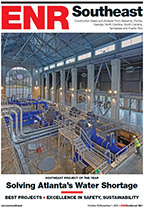The landscape of alternative construction project delivery, such as design-build and public-private partnerships (P3s) in the freight and rail transportation industries is rapidly evolving as alternatives to the traditional design-bid-build delivery method. Having been involved in more than 100 DBs or P3s, I find that the ways to lose projects can be broadly categorized in one of two major areas: teaming and neglect.
Prime submitters shouldn’t embark on teaming discussions until the following “Big Four” questions have been answered.
- Scope of Work. A solid understanding of the work elements is the appropriate first step in determining the challenges and demands of the project. A team with this understanding in the local market will be hard to beat, and further, if they have positive relationships and histories with the owner, all the better.
- Scale of the Project. The capacity of the team members should match the project. The insurance and bonding agencies of the world will drive these metrics for both the design and construction firms. Generally, the smaller the team member’s respective companies are, the more price-competitive the financial proposal will be.
- Project Schedule. There are two major components to the schedule – procurement and delivery.
Procurement Schedule: Here’s where the “neglect” factor weighs in. Do all the team members have adequate resources to understand the project and assign the proper resources during the proposal stage? This is particularly tricky in today’s maturing DB and P3 market, as many teams are assembled sometimes years before the procurement. Some team’s success rate is higher when they are competing with other teams who have just won a major project.
When a contractor has just won a major project, it usually tends not to be as aggressive as one who hasn’t and may not have the proper resources to assign to proposal development as one who has the proposed manager in-between assignments and can share the knowledge he or she has gained from past experience on this pursuit. So a winning team needs to be equipped with the proper resources during the proposal stage and be focused on finding the right solution for the owner.
Delivery Schedule: If the project has an overly demanding delivery schedule versus a more relaxed schedule, it may require team development with firms who have more depth. This could be a factor that determines the need to bring in more regional or national firms with more resources than the local firms with limited resources.
- Procurement. Understanding the nuances of the owner’s sources of funding on a project will obviate last-minute, fundamental changes to the structure of the team. For instance, a privately financed DB or P3 project will generally have fewer demands on Small and Disadvantage Business Enterprise (S/DBE) goals than the public sector. Some federal agencies have also required that 62% of the work not self-performed by the prime will need to be delivered by S/DBEs.
A lesson-learned occurred on a COE project some years ahead of the formal advertisement for procurement. Months before the procurement had formally begun, the teaming agreements in a prime-sub relationship had been executed and then the RFQ/P was initiated with the 62% S/DBE provisions causing the primes to re-evaluate their approach from a prime-sub relationship to a joint venture at the last minute. This distracted from the pursuit at a critical time in the procurement involving more senior management input, bonding and insurance input and, of course, attorneys.
How to Lose a P3 Project
When a project requires the team to not only design and construct a project but also finance, operate and maintain it for several years or decades, P3s have an entirely different dimension of teaming. The lead of these pursuits (often referred to as the “developer” or “concessionaire”) needs to augment the traditional DB team with financial advisers and sources, operations groups and maintenance companies. A concessionaire can have the right DB team, but if he doesn’t have the proper financial, operations and maintenance team members, it will usually be all for naught. All of these additional team members will be key in putting together the winning team.
Getting the “Big Four” issues solved as early as possible will go a long way toward presenting and delivering a successful DB or P3 project.




Post a comment to this article
Report Abusive Comment